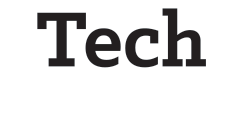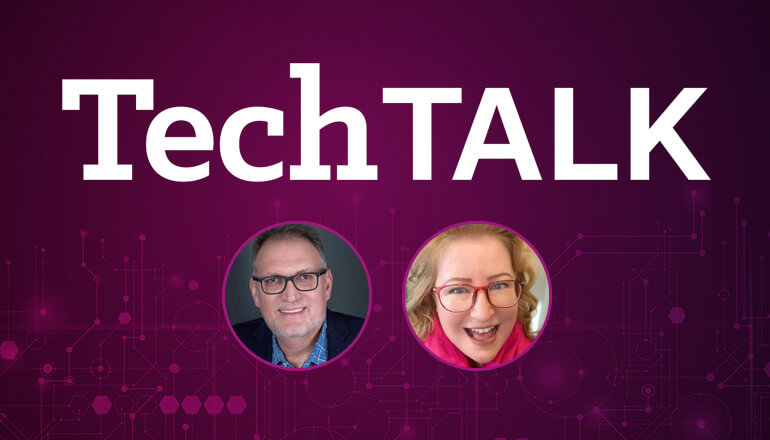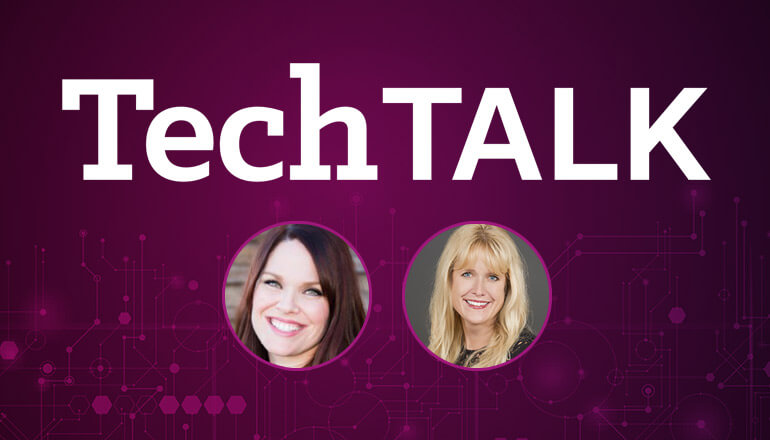Audio transcript:
Collaboration Predictions for 2020 and Beyond
Published July 7, 2020
[Music]
JILLIAN
Hello, and welcome to another Insight TechTalks. I'm Jillian Sloan, and I'm joined today by Paul Harrold, Director of Services for Insight Connected Workforce, and Joe Flynn, Director of Technical Architecture for Insight Connected Workforce. Welcome, gentlemen.
JOE
Thank you very much.
PAUL
Thanks for having us today.
JILLIAN
So nice to have you here today. Yeah, it's nice to see you. And by see you, I mean you know, virtually see you. Virtually.
This is our new world, right? It's all about collaboration and digital connectivity.
PAUL
Exactly.
JILLIAN
Quick topic of the day. So let's talk about that Joe, excuse me, Paul, I'm gonna start with you, actually. When clients had to make that shift immediately over to a remote workforce. What do you think the biggest challenges, what did you hear that clients were really struggling with in that initial transition?
PAUL
Great question and one that we hear all the time, really the biggest challenge that we've seen as an organization is our customers dealing with on premise solutions that don't reach well outside of the office. Again, it's either a lack of features or potentially, very limited features as they try to exit the brick and mortar type of facility and then work from home or work from any other location. We saw challenges with security concerns from the IT staff. User adoption was another area where, again, people were using the very basics of some of these collaboration tools within their offices, because they had the luxury to walk down the hall and have a conversation with somebody or grab something off the copier and walk it down and hand it to them. They've really been forced to adopt these tools and use them really to the fullest extent, so that they can maintain business continuity moving forward. Another area that everyone had to all of a sudden pick up from their office environments and move home, with the expectation that we still want to do the same level work and reach our customers satisfaction, et cetera. So, we did see our users having some hardware challenges as they moved into a home environment, potentially not having a laptop with ample processing power, maybe not having the video endpoints, so they had clear video with one another. You know, and then we've all felt it, is we have our families home, dealing with internet and we're bandwidth challenges. Kids want to watch the Netflix,
JILLIAN
That's right.
PAUL
and some of them play a game and we're trying to work and be on video. So, some of those challenges as well. And then really from the home environment, maybe just not having the the workspace or that office space to sit and have a quiet conversation with a good background and so on. So, those are some of the biggest challenges that we've seen.
JILLIAN
Yeah, and we've heard a lot about different platforms from the beginning, right? Zoom, Slack, Microsoft Teams, Cisco Webex, I mean how has the conversation about collaboration tools changed in the last several months?
PAUL
Well, COVID-19 this pandemic has really pushed the collaboration discussion, not only for the customers but really for the manufacturers you know to the forefront, the need for the workforce to be remote. Whether that be work from home or really work from any location and still have again, the audio and the telephony portions, meetings and videos, the content sharing, the chat, the document management and so on. Everybody, was forced into having to utilize those tools. So, while we had user adoption and some challenges there with people feeling comfortable with using all of those tools, we saw the manufacturers come out with security enhancements, we saw them come out with new features, new functionality, some new interfaces in certain cases. And, we saw triple digit percentages increase in some of the meeting minutes and meetings per day, since since COVID hit.
JILLIAN
Yeah, that's for sure. Joe, I think it's safe to assume by now that every company or at least most companies have made significant investments in collaboration solutions. Do you have any insight about, how companies are handling the adoption? Because we were pretty set off, we already had a couple solution tools, insight, but that wasn't necessarily the case for all companies. So, how's the adoption process been going for other companies?
JOE
Yeah, I mean, even at insight, there's adoption opportunities and I think other companies are seeing that too. As we see, like Paul mentioned, the amount of meeting minutes is up in sometimes the billions per day, we see users and not remote. So they're starting to leverage these collaboration tools much more because it's a way to interact with people, it's a way to engage with people. What we find is, they're using the very basics of these collaboration tools, they're using instant messaging, they're using voice and video. They're not leveraging the fact that, they can co-author documents instead of sending them an email. So, from an adoption perspective, they're still a lot of opportunity that companies can get because they're paying for these tools, right? Whether it's a Zoom, a Cisco or Microsoft, these tools aren't cheap. And when you talk about some companies can range from 20, 50 users up to a couple 100,000 users, they want to get the value of what it could bind for these licenses. So, it definitely there's an adoption plan that needs to be discovered within the company on a process. And then obviously, insight has the capabilities that can assist with that, but the more they help adopt, the more their end users will engage, the better their end user experience will be, especially from a remote workforce.
JILLIAN
Yeah, there's a reason, we're not just calling each other on our cell phones.
JOE
Exactly.
JILLIAN
We're working together on stuff. So, based on that, particularly with you talked about the new tools that these platforms are rolling out, greater collaboration, we're doing more than just texting and chatting, we're actually co-authoring documents. How do you think that organizations are now kind of reevaluating that remote work experience and what does that mean for the future of the workforce?
JOE
So in my eyes, in my opinion, let's say I think companies are gonna stick, you're gonna see a lot of companies shift more towards a remote workforce. We've far talked to companies daily that say, look previous, prior to COVID-19, we've never even imagined we could work remote. Now that we're forced to, we shifted our business processes, we've made some adjustments. Now we handle our internal IT support, but users are now able to do their jobs at home. In fact, they're probably saving money with having users at home. If you think from a real estate perspective, the more they can have user shift to work from home, you just have a better work life experience, they're probably more productive because they're not sitting sometimes 45 minutes or an hour and a half on the road, commuting back and forth to work. And then from a company perspective they can decrease, how much office space they have, whether you're paying for air conditioning, lights, electricity, all of that factors in. So, the benefit of remote work, I think is no doubt here to stay long-term, it's just how companies are gonna shift their IT and their support processes where it's gonna be successful or not.
JILLIAN
Yeah, to be honest to you, I filled up my gas tank maybe two times the last three months. So, I'm feeling those cravings.
JOE
I think we're all in that scenario, okay.
JILLIAN
Maybe the AC builds little bit higher but, Paul, this is over to you, when we start to head into Q3 and eventually into 2021. What do you think is gonna be the top priority for our clients? And do you foresee any other big changes happening to these collaboration tools even just to make, the collaboration even more seamless and move away from just the simple text messaging and even email, oh, my gosh, if I could get less emails, that would be so fantastic.
PAUL
Yes.
JILLIAN
So, what do you foresee happening in the coming months and year?
PAUL
Yeah, I mean, a couple of different things there and I think from the manufacturer side, we're gonna continue to see evolution of some of their feature sets, we're gonna see new feature sets coming out, they're really listening to the remote workforce on feedback as to, how can we enhance the experience and how can we make you more productive in your remote work environment. So, I think we're gonna continue to see that, we're starting to see an awful lot right now, different manufacturers are starting to come together, to come up with almost a best of breed solution, if you will. So, where somebody may have a weakness, for example, there may be somebody else who could complement that and we're seeing a little bit more interoperability between some of these manufacturers that we just really hadn't seen before. So, I think with that effort from the manufacturers, our experience is remote workers are, is going to be even better. Joe, touched on the evaluation of things like real estate, do we need these office spaces, do we need to put people on airplanes and have them travel, there's the work life balance aspect of it, there's quality of life, but then if we can pull some of that budget back in from, real estate costs and operational costs in a work environment, in travel, there should be more dollars and cents to be able to allocate over to our IT budgets, to again to continue to improve this work from home experience or remote work experience. And lastly, I'd say security is gonna be a very big piece to this. You can't talk collaboration without talking about security, now that people are moving out of the office environment, (clears throat) into a home environment initially, but then as we start to get out into work from anywhere, people will walk into a Starbucks and connect to WiFi there and they're gonna be sending data. Our organizations and their IT departments have to secure that that data and protect their intellectual property.
JILLIAN
Yeah, Joe, what about you, what do you think is gonna come?
JOE
No, I think he nailed it. I mean, we see companies I would like to Zoom's, a Microsoft, a Cisco's of the world, you see more conversation about integration across products, right? Because they know there's the best of breed certain based on what customers pay. They're gonna drive their users to leverage what they're investing in, right? So, the integration point I think, there are key for a lot of these vendors. And again, it's a required versus needed features, you're gonna see start driving. I think a lot of the required features are there and it's gonna be what needed feature to there, to increase the end user experience from a remote standpoint. I mean, Paul said initially, like when you're working from home, low bandwidth, where you're working, you can blur the backgrounds. These are features that as we start working remote, whether we're in a Starbucks, whether we're at home, whether we're in a hotel, they're needed, like they're now turning into more required, because you don't wanna be talking to someone who's sitting in their bedroom with an unmade bed behind them. You'd rather them use the green screen capability and make it go away. So, you're gonna see a lot of those type of features where it's just gonna enhance the experience overall, I think, which is nice.
JILLIAN
It's always the simple things that somehow are the like the best solutions, right?
PAUL
That's right. (laughs)
JILLIAN
Well, I think it's fair to say this conversation is far from over. We're gonna be talking about the future work for months and months to come. Do you guys have any final thoughts here, any advice to clients that are still kind of grappling with how to best enable a remote workforce?
PAUL
My take would be, just to embrace the technology and don't scared of the technology. I think as we've seen people shift initially, people didn't want to turn their video cameras on or people were afraid to use the tools outside of their comfort level. And over the course of the last three to four months, we've seen a pretty major evolution and people's willingness to adopt the tools, to use the tools and start to maximize the tools. And we're gonna find ourselves here in a position where people are so comfortable with these tools, they're gonna want, as Joe mentioned, additional enhancements, additional features brought in just to make their work from anywhere. experience that much better.
JILLIAN
Yeah, Joe, any closing thoughts somewhere?
JOE
Yeah, and I like what he said on the take, customers need to take it from a top down approach. Keep in mind, we've seen video increase drastically since COVID-19 started and many people in my age group, I'll use me as an example, are probably not the most comfortable with video, where if I take it to my daughters, they probably live on video 24/7, but if we handle it from a top down approach, where the leaders are promoting the video, promoting the interaction, promoting the collaboration and understanding. Companies have to understand, it's no longer just voice and video we're talking about. It's the data, it's co-authoring. Like you said, Jillian, it's getting out of email, getting in a tool where you can collaborate real time instead of having to send an email and wait for something to come back. But again, a top down approach has to be driven, otherwise users are just not gonna think everyone's bought in on.
JILLIAN
Yeah, that's great advice. Well, that's all the time we have for today, if you are looking for remote workforce enablement solutions or just tools to help your remote workforce work better, you can find all those resources available on insight.com. Thank you again for joining us for another edition of Insight TechTalks. Gentlemen, thank you again.
PAUL
Thank you, have a good day.
JOE
Thank you, Jillian.
[Music]










